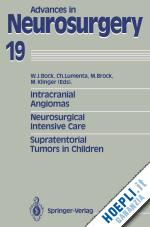President’s Opening Remarks.- Coordination of Neurosurgical Training in the Europe of the 1990s.- Winning Poster Presentations.- Perioperative Monitoring of Subarachnoid Hemorrhage: Transcranial Doppler Sonography and Somatosensory Evoked Potentials.- Mechanisms of K+-induced Glial Swelling.- Effects of Anesthetic Agents on Brain Edema and Cerebral Blood Flow from a Focal Cold Lesion in Rabbit Brain.- Single-Stage Neuro-rhinosurgical Operation and Management of Malignant Tumors of the Anterior Cranial Skull Base.- Vascular Malformations of the Brain.- Diagnostic and Interventional Neuroradiology of Brain Arteriovenous Malformations: Implications on Angioarchitecture for Embolization.- Embolization Techniques in the Treatment of Cerebral Arteriovenous Malformations.- Results of Combined Endovascular and Surgical Treatment of Intracranial Arteriovenous Malformations.- Indications, Technique, and Results of Microsurgical Treatment of Intracranial Arteriovenous Malformations.- Surgical Problems in Partially Embolized Angiomas.- Arteriovenous Malformations of the Brain: What is the Best Way to Treat Them?.- Arteriovenous Malformations of the Medial Surface of the Parieto-occipital Region and the Basal Ganglia.- Considerations on the Coexistence of Intracranial Arteriovenous Malformations and Aneurysms.- Follow-up After Treatment for Intracranial Arteriovenous Malformations.- Posterior Fossa Arteriovenous Malformations: Angioarchitecture in Relation to Hemorrhagic Episodes.- Clinical and Radiological Prognostic Factors in Cerebral Arteriovenous Malformations.- Venous Angiomas: Experience with Surgical and Nonsurgical Management.- Intracranial Venous Angiomas.- Congestive Cardiac Manifestations from Cerebrocranial Arteriovenous Shunts.- Neuropsychological Abnormalities inPatients with Cerebral Arteriovenous Malformations: A Pilot Study.- Cerebral Cavernous Hemangiomas: Treatment and Surgical Decisions.- Microsurgery of Cavernous Angiomas of the Brain with Special Reference to Cerebral Midline Localizations.- 667 Histologically Verified Cavernous Hemangiomas of the CNS: Review of Localization, Symptoms, and Signs, Diagnosis, and Results of Operative Treatment.- Asymptomatic Cryptic Vascular Malformations.- Supratentorial Tumors in Childhood.- Pediatric Brain Tumors.- Multidisciplinary Approach to the Treatment of Supratentorial Tumors in Children.- Treatment and Course of Malignant Supratentorial Brain Tumors in Childhood.- Interstitial Irradiation of Supratentorial Cerebral Gliomas in Childhood with Permanently Implanted Iodine 125: Preliminary Results.- Radiological Results of Intracavitary Brachytherapy of Cystic Craniopharyngioma in Childhood and Adolescence.- Long-Term Results of Combined Surgery and Radiotherapy of Pilocytic Astrocytomas in the Middle Cranial Fossa.- Discussion: PNET — A Melting-Pot of Unspecified Tumors?.- Prognosis of Supratentorial Gliomas in Children.- Proliferative Activity of Pilocytic Astrocytomas: Examination Using Monoclonal Antibody Ki-67.- Immunohistochemical Investigations with a Monoclonal Anti-Epidermal Growth Factor Receptor Antibody in Supratentorial Tumors in Children.- Neurosurgical Intensive Care.- Neurosurgical Intensive Care — An Interdisciplinary Field.- Neurosurgical Intensive Care: General Considerations.- Prognostic Value of Motor Evoked Potentials in Traumatic and Nontraumatic Coma.- The Temporal Structure of Information Processing in Patients Following Diffuse Head Injuries: Electrophysiological Studies.- TCD, SEPs and ICP: Comparative Analysis in Severe Head Injury.- ParenteralNutrition in Patients with Spontaneous Intracranial Hemorrhages.- Susceptibility to Infection During Continuous Thiopentone Therapy.- Infection Rate and Bacterial Spectrum in 413 Patients of a Neurosurgical Intensive Care Unit: Results of a 2-year Prospective Study.- Risk During the First Hours After Severe Head Injury.- Disturbances of Water-Electrolyte Regulation After Surgery of the Hypothalamus and Pituitary Region.- CBF Dynamics During Hyperventilation Therapy for Intracranial Hypertension.- THAM in Traumatic Brain Swelling: A Comparative Experimental and Clinical Study.- Effects of the Antihypertensive Drug Ketanserin on Intracranial Pressure in Patients with Head Trauma.- A Comparison Between Mannitol and Glycerol Therapy for Intracranial Hypertension.- Decompressive Craniectomy After Severe Head Injury: Useful Therapy in Pathophysiologically Guided Indication.- Safety of Fraxiparine Administration in Neurosurgical Patients: Preliminary Report.











